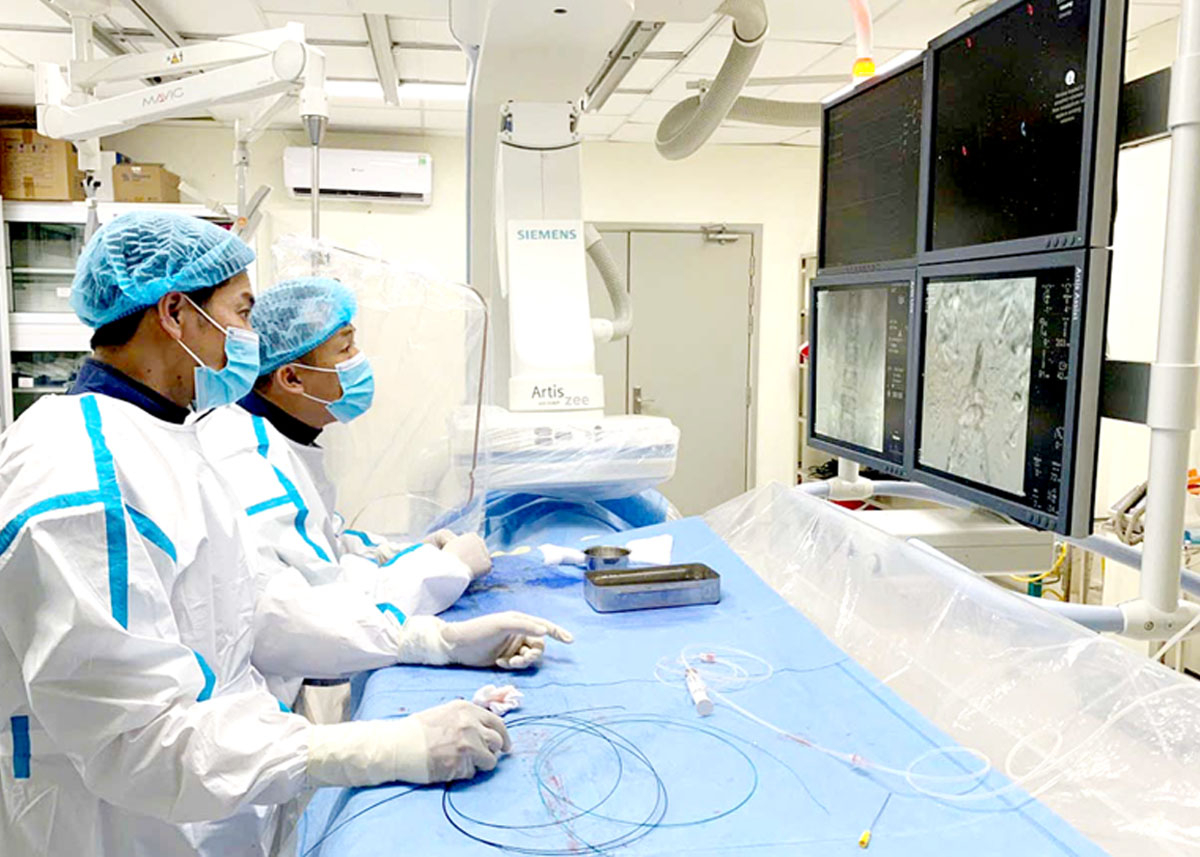Applying embolisation in the treatment of prostate fibroids in Ha Giang
BHG - In recent years, with the spirit of innovation and improvement of the quality of public health care, the Provincial General Hospital has learned and successfully applied many advanced methods and techniques in medical examination and treatment. The method of embolisation in the treatment of prostate fibroids is an effective method, newly applied successfully by the team of doctors and nurses.
Prostate fibroids are a disease related to men, usually benign tumours. The larger the fibroids, the more they compress the urethra and bladder, making urination difficult, the patient will have urinary retention, and many people also have urinary tract infections. Depending on the severity, this disease also affects the psychology and daily quality of life.
 |
| Doctor Tran Minh Chuong (second from left) and his colleague at the Provincial General Hospital perform an embolisation procedure to treat prostate fibroids. |
Mr Do Xuan Lanh, in Residential Area No.14, Minh Khai Ward, Ha Giang City, is 76 years old this year and has been haunted by prostate fibroids for 20 years. He said that many sleepless nights, often having to wake up 4-5 times to urinate are tiring and haunting, and the quality of life is seriously reduced. Although he has been to many places, many hospitals with many types of treatment drugs, the disease increases with age, the prostate fibroids at their largest weigh about 80 grams. Worried that the surgical method would have the risk of complications, Mr Lanh was fortunate to have access to a new non-invasive intervention method. That is the embolisation method in the treatment of prostate fibroids performed by doctors of the Department of Diagnostic Imaging, Provincial General Hospital.
Doctor Tran Minh Chuong, Department of Diagnostic Imaging, said the case of patient Do Xuan Lanh is one of 10 cases to date that have been treated with embolisation to treat prostate fibroids. This method is not new in some large hospitals at the upper level but is the first time it has been applied in Ha Giang.
After about one year of treatment, Mr Do Xuan Lanh’s fibroids gradually shrank, and the uncomfortable symptoms of prostate fibroids also gradually decreased. Mr Lanh’s tumour was recently examined and almost returned to normal size, weighing about 29 grams. The joy was even greater when he returned to sleep, no longer having to toss and turn every night to wake up to urinate. He also said that he had undergone gentle surgery with only anaesthesia. About one day after the surgery, he was discharged home and used medication as prescribed by the doctor.
According to doctors at the Provincial General Hospital, embolisation in the treatment of prostate fibroids is a specialised vascular technique. To perform this technique, high-tech machinery is required, which is the DSA angiography machine. This intervention method has many advantages in that it is minimally invasive, only requiring a very small incision on the arm or thigh to insert a catheter into the artery to perform the surgery. After that, the doctors will handle the technique, embolise the blood vessels, and prevent blood from feeding the fibroid tumour, causing the fibroid to gradually shrink and reduce in size after surgery. The time to perform a surgery is not long. If the surgery is performed from the arm, the patient will be able to move, sit up and be discharged from the hospital sooner than surgery from the inner thigh or compared to surgery using the traditional method.
Along with specialised vascular techniques, the embolisation method with many advantages for treating prostate fibroids, will be a new direction for treating patients. The application of this method affirms the professional ability and good technical equipment conditions of the Provincial General Hospital. It is expected that in the near future, more prostate fibroid patients will be treated with this advanced method.





READER COMMENTS